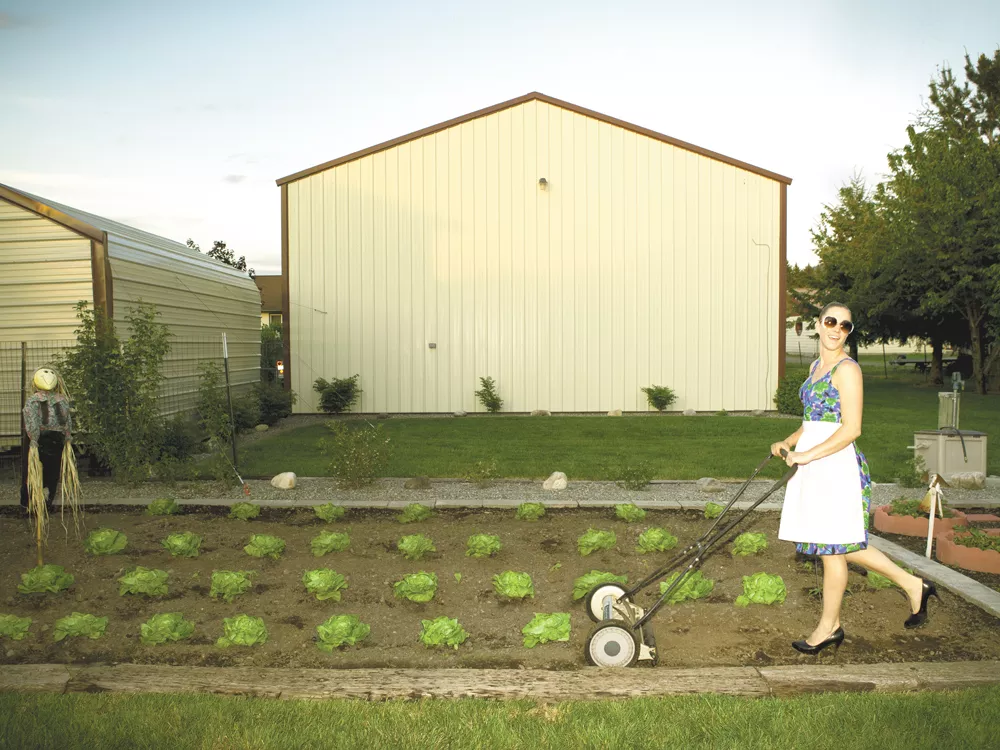Valerie Neilson dreams of gardens. Literally. Recently she awoke at three in the morning, having just dreamed about where to plant a bushel of cucumbers.
Neilson, a former realtor and appraiser, and her partner, Geoff Loftin, the official “workhorse lawn boy,” have created their own little Garden of Eden on the South Hill.
The space between the road and the sidewalk in front of their house is planted with garlic and mulched with straw. The same space in front of their garage is speckled with white and yellow flowers from the budding strawberries and spindly zucchini plants.
Inside their iron-gated fence is a beautiful display of chickens and edibles. Over the course of about five years, the couple has replaced all but a few patches of grass with rows of garlic so tall they’re mistaken for corn, and fans of chives with purple flowers.
Interspersed throughout the vegetables are lilacs, climbing honeysuckles and bulbous peonies.
Throughout the entire lawn is a dizzying display of blueberries, 6-year-old beds of asparagus, grapes, potatoes, habaneros, tomatoes, broccoli, climbing beans, Romaine lettuce, raspberries, fruit trees and more.
“I’ve always said I wanted to be a farmer,” Neilson says. “Now I’m an in-town farmer.”
The couple is part of a growing movement called Food Not Lawns. The premise is simple: Lawns are mosly aesthetic yet require maintenance and resources, but vegetable gardens feed people.
First Lady Michelle Obama has even turned the south lawn of the White House into a vegetable garden to feed her family and honor Eleanor Roosevelt’s Victory Garden — gardens planted in public and private spaces during both World Wars to reduce pressure on the public food supply.
The international movement is picking up momentum in Spokane, where a handful of local gardeners are saying no to grass.
The Food Not Lawns movement has an unofficial guidebook, Heather Flores’ Food Not Lawns, How to Turn Your Yard into a Garden and Your Neighborhood into a Community, published in 2006.
The Food Not Lawns movement sprang from Oregon Food Not Bombs activists — people who feed homeless people, typically in parks.
Craig Goodwin spoke with Flores in 2008 when his family decided to turn their Millwood lawn into a garden as part of a yearlong experiment with local food. Goodwin chronicled their journey on their website and the 2011 book Year of Plenty.
The family used a sod cutter to create a large vegetable garden shaped like a labyrinth in their front lawn. They have no plans to revert back to grass.
“Gardens are a better use of resources, like fertilizers and water,” Goodwin says. “It’s intuitive. We are growing food that feeds our family instead of just growing something that looks nice.”
“When I see a lush green lawn, I see all the chemicals and resources that went into creating that. I can maintain a garden without any chemicals, and it’s a better use of space, and it’s rewarding work,” he says.
Goodwin initially feared that other residents of their suburban neighborhood would complain. The family has gotten “a few strange looks along the way.” Mostly though, he says neighbors are curious and supportive.
He says Spokane in general is becoming keen on the idea of vegetable lawns.
“I
have seen more people creatively using space to grow food,” Goodwin
says. “Spokane isn’t an ultra-urban area. A lot of it isn’t that
disconnected from agriculture, and growing food is just kind of part of
life.”
Neilson uses a broomstick to trace a small gully in the coffee-colored compost. Next, she sprinkles seeds of Romaine lettuce and lightly covers them with soil.
Before that, compost from their two compost tumblers and coffee grounds from the Rocket Market created the vegetable bed, which was turned with a broadfork — a tool almost like a pitchfork that breaks up soil.
Seven rain barrels circle the house and collect water for the plants, making Neilson’s organic vegetable garden a minimalist’s masterpiece.
“I just like to do things by hand,” she says smiling. “None of this is really planned. We just rip things up and see what happens, which means it’s never done and it changes all the time.”
The couple rents a sod cutter from a locally owned hardware store for heavy-duty grass removal. A small circle of grass with a patio chair and space for the dogs remains, as does a small patch around their vintage clothesline.
Neilson says her garden began taking shape because she “ran out of places to put stuff.”
Today, her garden book is filled with hand-drawn maps, empty seed packages and notes about planting tomatoes next to carrots or which pepper seeds to save. Neilson says she gardens because it’s therapeutic.
“I don’t know how to put words to it,” she says. “It’s just so relaxing. The second impetus is you get real food.”
Her partner, Loftin, agrees. They take pride in tending to the vegetables and “taking care of their little corner of the world.”
“Some
of the neighbors wish we had a lawn, but it seems like such a waste,”
Loftin says. “You just gotta convince yourself that the front yard isn’t
necessary.”
For tips on turning your lawn into a garden visit yearofplenty.org.

